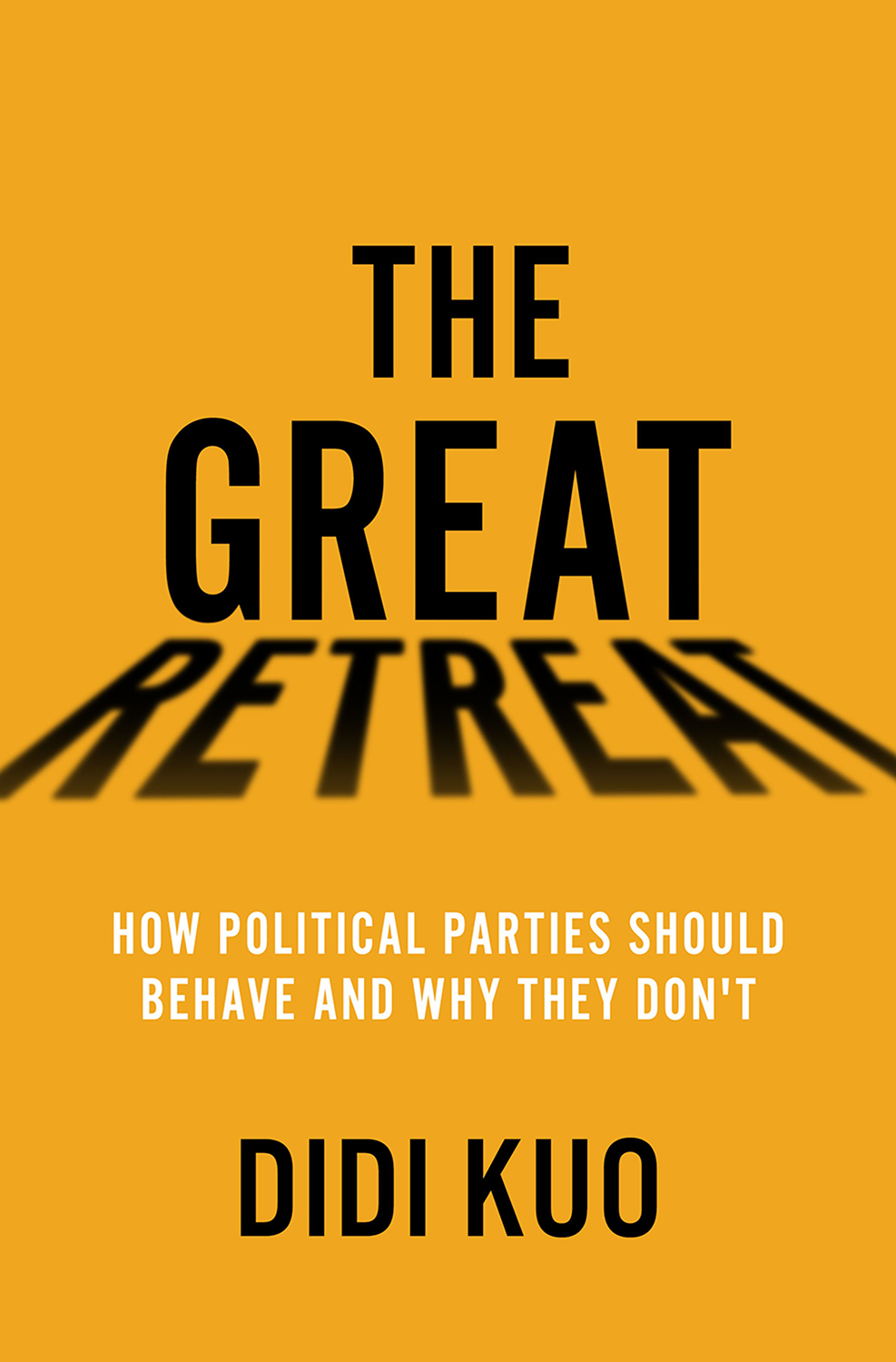Excerpted from The Great Retreat: How Political Parties Should Behave and Why They Don’t by Didi Kuo.
In a healthy democracy, parties compete by offering different sets of policies to voters and cultivating a loyal base of voters whose demands form the basis of party policy. Scholars have also long acknowledged the importance of linkages between citizens and parties. This refers to the myriad relationships, informal and formal, that help to establish voters’ attitudes and loyalties to parties. At the heart of today’s crisis is a disconnect between citizens and leaders, a belief that politicians do not serve the interests of the public. The anxieties about parties dating to Washington’s Farewell Address resonate today, at a time when parties seem to divide much more than they unite, and when antiparty sentiment has become pervasive in the United States and elsewhere.
While parties still claim to represent and speak for the people, they may have no connection to individuals. These days, joining a party might mean receiving emails soliciting campaign contributions or following candidates on social media. Campaigns are branding and advertising exercises. The parties market their candidates through a vast network of political strategists and consultants. Candidates rely on support not from residents of their districts but from far-away fans willing to donate money. While parties once reached citizens through membership and local party offices, they now rely on a political industry of pollsters and strategists who target potential voters. It is not clear to voters or even to aspiring candidates how to access their local party offices, if they exist.

Courtesy Oxford University Press
Candidates and campaigns may not even need to work closely with whatever formal party organization exists. As a result, it can be very difficult to distinguish what the party actually is or who leads it. Presidents and vice presidents are often the most visible heads of their parties, but they do not occupy official leadership positions within the party. In Congress, the parties must elect leaders (the Speaker of the House and the Senate majority leader), but again, these individuals are not necessarily party leaders. The Republican National Committee and the Democratic National Committee have official leadership (chairs, vice chairs, secretaries, treasurers), but their influence is subordinate to a world of donors and interest groups that devote significant resources to their own political agenda.
Parties as connectors between society and government require us to go beyond election results and voter attitudes. Instead, we must examine whether parties are integrative (socializing people into politics), representative (claiming to act on behalf of a group interest), and responsive (shaping policy decisions in accordance with their responsibility to integrate and represent voters). Parties also have a moral component, in that perceptions of the legitimacy of government itself run through the work done by parties. It is parties that actually command the state, and then sell the public on whether or not the state is responsive and trustworthy.
We often think of the state or government as a clunky bureaucratic apparatus that is somewhat orthogonal to politics. If anything, it might be the case that parties politicize agencies when it is in their interest to do so.
The perception that citizens have of government rests in large part on how parties claim credit for policies. Parties have become more reluctant to tout the benefits of state action and have scaled back many social policies as well. In doing so, they have deprived themselves of the ability to win the trust of voters or cultivate attachments based on what a party actually provides voters. Such large-scale economic, technological, and social disruptions as globalization, immigration, extremism, and inequality are seen as challenges that democracies must manage and respond to. They are imagined to be external forces acting upon governments. And because governments have not responded in ways people find satisfactory, democratic legitimacy has eroded. Antiparty sentiment is seen as part and parcel of this erosion of trust in our democratic institutions.
But these changes weren’t simply external. Instead, internal political choices are made by parties across the political spectrum, across successive governments. Parties have retreated from the representative functions they once performed. As parties grew more professional and campaign-oriented, they also became less responsive, shedding the representation and mobilization functions they once performed. Citizens are no longer recruited and socialized into parties through active engagement and community networks. Indeed, parties have outsourced many of their traditional intermediary and mobilization functions to outside groups. Instead of parties, it is advocacy coalitions, nongovernmental organizations, lobbying firms, media, and social movements that now provide messages and information to voters. As a result, voters are likely to hear about the failures of parties rather than hear parties defend and justify how political decisions are made.
Instead of parties, it is advocacy coalitions, nongovernmental organizations, lobbying firms, media, and social movements that now provide messages and information to voters.”
Changes to party organization therefore have significant consequences for representation. Parties determine which factions in society are mobilized and whose views are taken into consideration when making policy. When parties are strong intermediaries, they can effectively manage the relationship of democracy and capitalism, even if the result is a democracy in which the rich have more power. When parties are weak intermediaries, they lay the groundwork for serious, potentially irreparable imbalances in who democracy serves.
For more information
From The Great Retreat by Didi Kuo. Copyright © 2025 by Didi Kuo and published by Oxford University Press. All rights reserved.